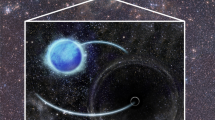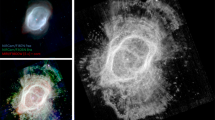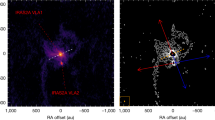Abstract
Replying to: C. M. Gaskell Nature 463, 10.1038/nature08665 (2010)
Gaskell1 makes the point that the profile of the Balmer lines in the candidate binary supermassive black hole2 AGN J1536+0441 bears some similarity to those that are thought to arise from disk emission in other objects. He further argues that two predictions of the competing binary black-hole hypothesis are (1) radial velocity changes that are interpretable in terms of the binary orbit, and (2) line fluxes in the two peaks that vary independently.
Similar content being viewed by others
Main
The similarity to disk emitters has been bolstered by subsequent spectroscopic observations3,4, which show a red extension to the line profiles. However, the degree of similarity is debatable; the sharpness and strength of the blue peak and the presence of a central broad component make the line profiles in J1536+0441 unusual, if not unique. When sharp peaks are seen in objects thought to be disk emitters, these peaks are transient. As the simple disk emission models do not reproduce these characteristics at the extreme levels seen in J1536+04415, it is unclear whether their presence excludes the disk interpretation or not.
It is certainly true that the strongest evidence for determining the nature of this object will come from spectroscopic monitoring to detect radial velocity changes and flux changes within the line profiles. Initial evidence is inconclusive3,4, in that no changes have been detected over a little less than one year. This finding excludes some of the orbital parameter space, but not that interpretation. Several more years of unchanging fluxes and velocities would push both explanations into uncomfortable areas, as the material in the disk must be orbiting as well.
It may be that J1536+0441 is a single AGN with an emission line profile resulting from a disk configuration of material. There are credible arguments for and against that hypothesis as well as the possibility that the system is a bound system of two supermassive black holes. Whichever the case, Gaskell is correct that the presence of at most one such object out of a sample of 17,500 has interesting implications for the process by which supermassive black holes merge.
References
Gaskell, C. M. Close supermassive binary black holes. Nature 463, 10.1038/nature08665 (2010).
Boroson, T. A. & Lauer, T. R. A Candidate sub-parsec supermassive binary black-hole system. Nature 458, 53–55 (2009)
Chornock, R. et al. The quasar SDSS J1536+0441: an unusual double-peaked emitter. Preprint at 〈http://arXiv.org/abs/0906.0849〉 (2009)
Lauer, T. R. & Boroson, T. A. HST images and KPNO spectroscopy of the binary black hole candidate SDSS J1536.22+044127.0. Astrophys. J. 703, 930–938 (2009)
Gezari, S., Halpern, J. P. & Eracleous, M. Long-term profile variability of double-peaked emission lines in active galactic nuclei. Astrophys. J. 169 (Suppl.). 167–212 (2007)
Author information
Authors and Affiliations
Ethics declarations
Competing interests
The authors declare no competing financial interests.
Rights and permissions
About this article
Cite this article
Boroson, T., Lauer, T. Boroson and Lauer reply . Nature 463, E2 (2010). https://doi.org/10.1038/nature08666
Issue Date:
DOI: https://doi.org/10.1038/nature08666
Comments
By submitting a comment you agree to abide by our Terms and Community Guidelines. If you find something abusive or that does not comply with our terms or guidelines please flag it as inappropriate.



